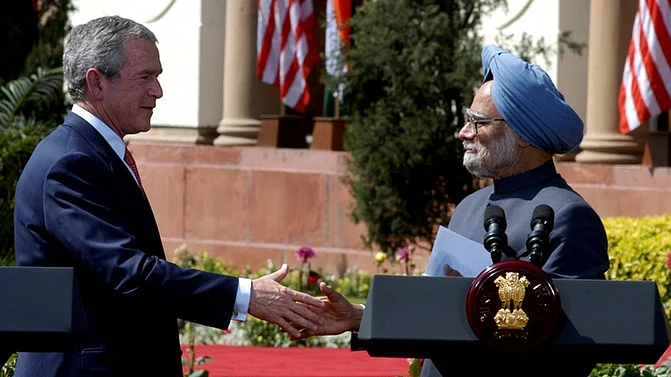Cut to the Chase
- Hyde Act exempts New Delhi from signing the Nuclear Non-Proliferation Treaty.
- On February 2, 2009, India signed an India-specific safeguards agreement with the International Atomic Energy Agency (IAEA).
- The Left withdrew support from UPA Govt on the issue of Indo-US civil nuclear deal.
- The CLiNDA safeguards the victims of a nuclear accident for a quick compensation.
- When Modi visited the US in 2015 a breakthrough without dilution of the liability law was reached.
The Civil Nuclear Framework
On July 18, 2005, in a joint statement by the then Prime Minister Manmohan Singh and US President George W Bush, India and the US agreed upon a Civil Nuclear agreement framework.
India agreed to a phased separation of its civil and military nuclear facilities. And to bring its civil nuclear facilities under the International Atomic Energy Agency (IAEA) standards.
President Bush not only assured India that it will help in achieving full civil nuclear energy cooperation but also agreed to work with Nuclear Suppliers Group (NSG) to enable full civil nuclear energy supply and trade.
The Hyde Act, 2006
A year later in 2006, the US House of Representatives passed the ‘Henry J Hyde United States-India Peaceful Atomic Energy Cooperation Act’. This was in compliance with the 2005 civil nuclear cooperation framework.
The Hyde Act stipulates that Washington and New Delhi will cooperate on nuclear issues and exempt New Delhi from signing the Nuclear Non-Proliferation Treaty (NPT).
In November 2006, the US Senate passed the ‘United States-India Peaceful Atomic Energy Cooperation and US Additional Protocol Implementation Act’ to exempt from certain requirements of the Atomic Energy Act of 1954 in United States exports of nuclear materials, equipment, and technology to India.
Political Ramifications Back Home
The Left parties withdrew support from the Manmohan Singh government on the issue of the Indo-US civil nuclear deal. The Left was opposed to the UPA government going ahead with International Atomic Energy Agency (IAEA) safeguards agreement.
Prime Minister Manmohan Singh survived a floor test on the July 10, 2008.
On August 1, 2008 the IAEA Board of Governors approved unanimously and on February 2, 2009, India signed an India-specific safeguards agreement with the IAEA.
CLiNDA 2010
The Civil Liability for Nuclear Damages Act was passed in Parliament in August 2010. The CLiNDA safeguards the victims of a nuclear accident for a quick compensation. The liability of operators has been capped at $300 million.
Modi Magic and The 2015 Breakthrough
Prime Minister Narendra Modi and US President Barack Obama announced a breakthrough to the logjam over the operationalisation of the deal during US President Barak Obama’s visit to India in January 2015. The US was apprehensive of sections 17(b) and 46 in CLiNDA 2010.
The US felt these provisions would indemnify companies supplying nuclear reactors and parts to India beyond what was required by international law or Convention on Supplementary Compensation (CSC). But India and US reached a breakthrough without dilution of the liability law.
US reportedly gave up the earlier stand of tracking nuclear supplies to India.
The Journey So Far
During PM Modi’s visit to US last year both the countries had agreed to create a contact group to expedite the implementation of Civil Nuclear Deal agreement.
The India-US contact group met thrice between September 2014 and February 2015. India has made it clear that the CLiND Act of 2010 is compatible with the 1997 Convention on Supplementary Compensation.
India has also proposed to create an insurance pool.
This pool will be a consortium of five public sector insurance companies and the Indian government will contribute Rs 750 cr. The government has also proposed to form a nuclear liability fund over next 10 years.
Over the next 10 years India will need to provide 400 million of its citizens with reliable energy, according to Nisha Desai Biswal, US Assistant Secretary for South and Central Asian Affairs.
To secure that future, the United States and India – through clean energy partnerships – have mobilised nearly $3 billion dollars in renewable energy investments since 2009.
